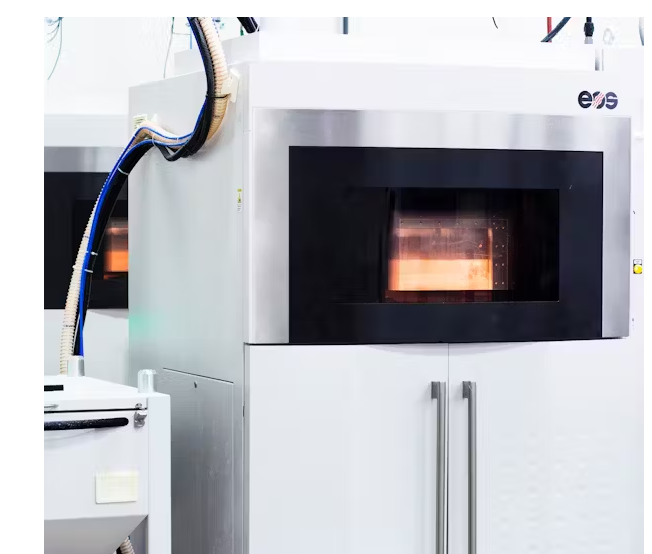Time to read: 6 min

— Matt Schmidt, Senior Solutions EngineerWhat Is Selective Laser Sintering (SLS)?
SLS is a powder bed fusion technology that works with plastic powders and was originally developed in the mid-1980s. It’s often compared to other methods like FDM and, of course, DMLS. SLS uses one or two types of lasers, most commonly a CO2 laser, to trace out the cross-section of a part and sinter the plastic particles together. Once every layer is formed, the final build is complete. For a visual example, you can see a photo of one of our SLS machines at Unofactory in action below.An SLS 3D Printing Machine at Unofactory
An SLS 3D printing machine at Unofactory.What Is Direct Metal Laser Sintering (DMLS)?
Like SLS, DMLS involves powder bed fusion technology and sintering, but it works with metals instead of plastics. DMLS became a commercialized process in 1995 and works by fusing metal powder particles together with a laser until every layer is complete. These printers also have a chamber filled with inert gas to reduce the risk of combustion and oxidation. You can see a diagram showing the parts of a DMLS printer below.DMLS Schematic
DMLS SchematicComparing These 3D Printing Processes
| Attribute | SLS | DMLS |
|---|---|---|
| Typical layer height | 100–120 microns | 30–40 microns |
| Typical tolerance standards | ± 0.015” or ± 0.002" per inch — whichever is greater* | +/- 0.005” for the first inch, plus +/- 0.002” for every inch that comes after |
| Typical build volume | 330 x 330 x 580 mm | 250 x 250 x 250 mm |
| Minimum recommended feature size | 1 mm | 0.5 mm |
| Parts need support structures | No | Yes |
| Has isotropic material properties | Yes | Yes |
| Material types | Thermoplastics like polyamides and nylons, metal, ceramic, and glass | Metals and alloys such as aluminum, copper, and stainless steel |
| Print volume | Can print builds around 2 feet in length | Smaller builds, around a 10-inch cube in size |
| Can print in metal | No | Yes |
Cheaper for prototyping and testing out product forms
Parts don’t need supports for printing
Can be dyed different colors and vapor smoothed
Larger build volumes than DMLS printers
Can make more parts at once
Can create high-strength parts with many different types of metals
Parts are super durable and have great chemical, mechanical, and thermal properties compared to SLS
Parts usually have better resolution than SLS parts
Limited to only working with plastics
Not as great mechanical properties as DMLS parts
Parts are more prone to shrinking and warping
DMLS tends to be more expensive due to high material costs
Prints need support structures during the build process
Smaller build volumes
Prints smaller quantities than SLS machines
Need metal or plastic 3D printed parts?
Get Your Instant QuoteAlternative Methods
While SLS and DMLS have their fair share of perks, there are a couple of alternative printing options you can consider depending on your project:
Multi-jet fusion (MJF): This is also a type of powder-bed fusion process (and one that we offer at Unofactory). MJF is a good alternative for SLS because it works with similar polyamide materials but uses a printer head that deposits the materials more like an inkjet printer, as opposed to the laser used in SLS.
Metal binder jetting: We also offer metal binder jetting, which works with metal like DMLS. It uses a print head to lay out a binding agent that fuses metal layers together, which are then cured and later sintered or infiltrated with bronze. It’s much cheaper than DMLS but has a higher chance of shrinkage and more pores (and often not as fine of features).
What are the costs for SLS and DMLS printing?
How do the surface finishes compare between SLS and DMLS?
At Unofactory, you won’t be short of 3D printing options. Speak to our team for customized help or use our online quote generator to get pricing for metal 3D printing, carbon digital light synthesis, stereolithography, and more.Disclaimer
The content appearing on this webpage is for informational purposes only. Unofactory makes no representation or warranty of any kind, be it expressed or implied, as to the accuracy, completeness, or validity of the information. Any performance parameters, geometric tolerances, specific design features, quality, and types of materials or processes should not be inferred to represent what will be delivered by third-party suppliers or manufacturers through Unofactory’s network. Buyers seeking quotes for parts are responsible for defining the specific requirements for those parts. Please refer to our terms and conditions for more information.




